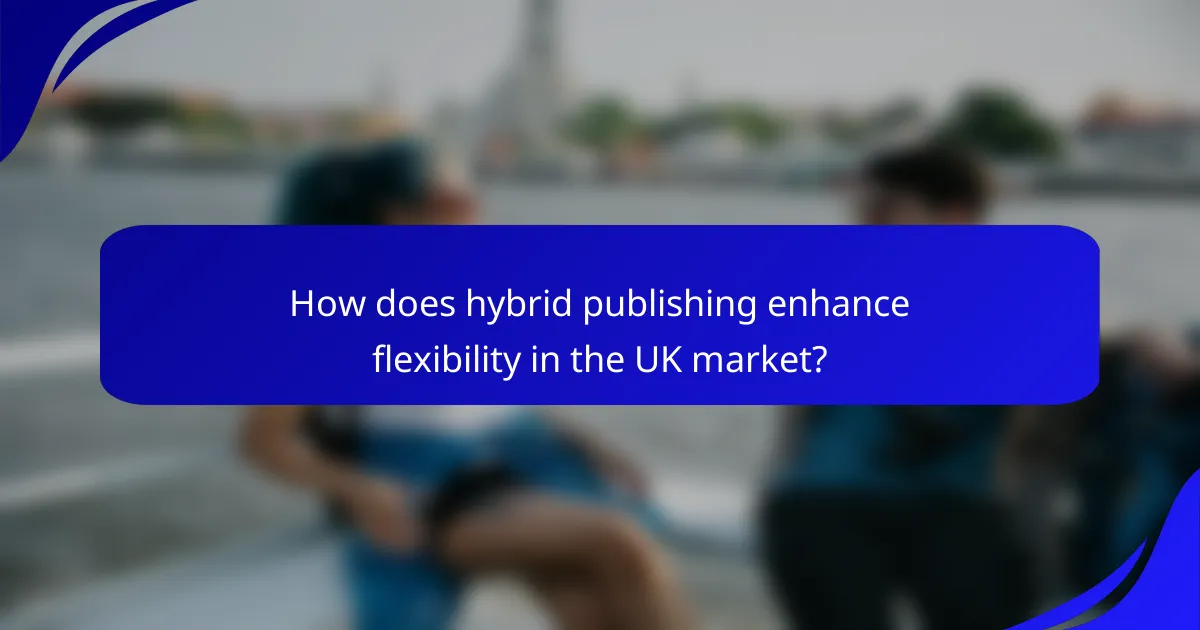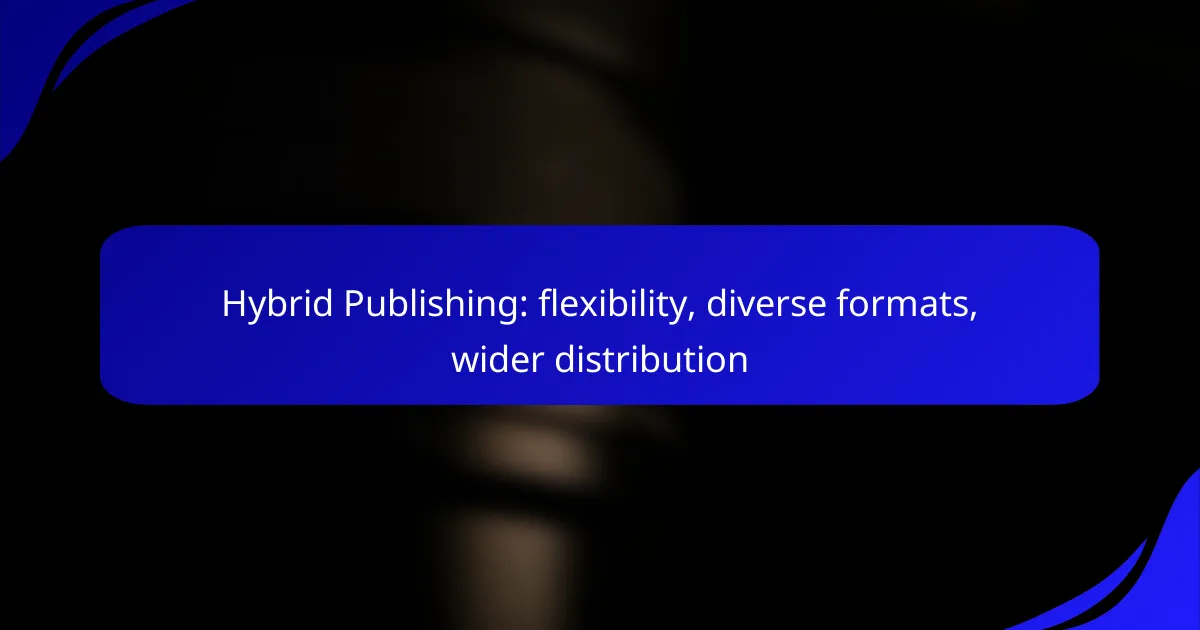Hybrid publishing revolutionizes the publishing landscape by offering authors unparalleled flexibility in choosing formats and distribution methods that suit their unique needs. By blending the strengths of traditional publishing with the benefits of self-publishing, this model allows for a more adaptable approach, catering to diverse reader preferences and enhancing distribution opportunities across multiple platforms.

How does hybrid publishing enhance flexibility in the UK market?
Hybrid publishing enhances flexibility in the UK market by allowing authors to choose from various formats and distribution methods tailored to their needs. This approach combines traditional publishing’s strengths with the advantages of self-publishing, enabling a more adaptable and responsive publishing process.
Multiple format options
Hybrid publishing offers a range of format options, including print, eBooks, and audiobooks. Authors can select the formats that best suit their target audience and marketing strategy, allowing for a more personalized approach to content delivery.
For example, a novel might be released as a paperback for traditional readers, while also being available as an eBook for tech-savvy consumers. This versatility can significantly increase reach and engagement.
Customizable distribution channels
With hybrid publishing, authors can customize their distribution channels to maximize exposure. They can choose to distribute through online platforms, local bookstores, or even direct sales via their websites.
This flexibility allows authors to target specific markets effectively. For instance, an author might focus on selling eBooks through platforms like Amazon while simultaneously partnering with local shops for print sales, catering to both digital and physical readers.
Adaptable content strategies
Hybrid publishing enables authors to develop adaptable content strategies that can evolve based on market feedback. Authors can quickly pivot their marketing tactics or update content formats in response to reader preferences and trends.
For instance, if an eBook gains popularity, an author might decide to create a series of related audiobooks or supplemental materials. This responsiveness can lead to increased sales and a stronger connection with the audience.

What diverse formats are available in hybrid publishing?
Hybrid publishing offers a variety of formats, including print-on-demand services, digital eBooks, and audio formats. These options provide flexibility for authors and cater to different reader preferences, enhancing distribution opportunities across multiple platforms.
Print-on-demand services
Print-on-demand (POD) services allow authors to print physical copies of their books only when orders are placed. This model reduces upfront costs and inventory risks, making it accessible for independent authors. Popular POD platforms include Amazon’s KDP, IngramSpark, and Lulu.
When using POD, consider factors like print quality, distribution channels, and pricing. Authors can typically set their own retail prices, but must account for production costs to ensure profitability. It’s advisable to compare different services to find the best fit for your needs.
Digital eBooks
Digital eBooks are electronic versions of books that can be read on various devices, such as eReaders, tablets, and smartphones. They are easy to distribute through platforms like Amazon Kindle, Apple Books, and Google Play Books, allowing authors to reach a global audience.
When publishing eBooks, authors should focus on formatting and cover design to enhance reader experience. Additionally, consider pricing strategies, as eBooks often sell for lower prices than print editions, typically ranging from a few dollars to around twenty dollars, depending on the content and market demand.
Audio formats
Audio formats, including audiobooks and podcasts, are increasingly popular among readers who prefer listening to content. Authors can produce audiobooks through platforms like Audible or ACX, which facilitate distribution and sales.
Creating an audiobook involves narrating the text, which can be done by the author or a professional voice actor. It’s essential to invest in quality recording equipment and editing to ensure a polished final product. Pricing for audiobooks can vary widely, often ranging from ten to thirty dollars, depending on length and production quality.

How does hybrid publishing enable wider distribution?
Hybrid publishing allows authors to reach a broader audience by combining traditional and digital publishing methods. This approach leverages various distribution channels, enhancing visibility and accessibility for diverse formats.
Global reach through online platforms
Online platforms are essential for hybrid publishing, providing access to a global audience. Authors can publish eBooks and print-on-demand titles on platforms like Amazon Kindle Direct Publishing, Apple Books, and Google Play Books, which cater to millions of users worldwide.
Utilizing these platforms often means lower upfront costs and the ability to reach readers in multiple countries without the need for physical distribution. This flexibility allows authors to experiment with pricing and marketing strategies tailored to different regions.
Partnerships with retailers
Establishing partnerships with both online and brick-and-mortar retailers can significantly enhance distribution. Hybrid publishers often collaborate with local bookstores and larger chains to stock physical copies, expanding their market presence.
These partnerships can also include promotional events or book signings, which can drive sales and increase visibility. Authors should consider negotiating favorable terms that allow for better margins while ensuring their works are accessible to a wider audience.
Utilization of social media
Social media platforms are powerful tools for promoting hybrid publishing efforts. Authors can use channels like Facebook, Instagram, and Twitter to engage with readers, share updates, and promote new releases, creating a community around their work.
Effective social media strategies include regular posts, targeted ads, and interactive content such as polls or Q&A sessions. Building a strong online presence can lead to increased sales and a loyal readership, making it an essential component of a hybrid publishing strategy.

What are the key criteria for choosing a hybrid publishing model?
When selecting a hybrid publishing model, consider factors like target audience, cost-effectiveness, and distribution goals. These criteria will help determine the best approach for maximizing reach and engagement while balancing expenses.
Target audience considerations
Understanding your target audience is crucial in a hybrid publishing model. Identify their preferences for content format, such as e-books, print, or audio, to tailor your offerings effectively. Conduct surveys or analyze market trends to gather insights about their reading habits and preferred platforms.
Additionally, consider the demographics of your audience, including age, location, and interests. This information will guide your content creation and marketing strategies, ensuring that your publications resonate with the intended readers.
Cost-effectiveness analysis
Cost-effectiveness is a vital factor when choosing a hybrid publishing model. Assess the expenses associated with different formats, such as production costs for print versus digital distribution fees. Generally, digital formats tend to have lower overhead costs, while print may require higher upfront investment.
Evaluate potential revenue streams, including direct sales, subscriptions, and royalties. A hybrid approach can help diversify income sources, but it’s essential to analyze which formats yield the best return on investment based on your specific audience and market conditions.
Distribution goals
Your distribution goals will significantly influence your choice of a hybrid publishing model. Determine whether you aim for broad reach across multiple platforms or a targeted approach focusing on niche markets. This decision will affect your format selection and marketing strategies.
Consider the distribution channels available, such as online retailers, local bookstores, or direct-to-consumer sales. A hybrid model allows for flexibility in distribution, enabling you to adapt your strategy based on performance metrics and audience feedback.

What are the benefits of hybrid publishing for authors in the UK?
Hybrid publishing offers UK authors a blend of traditional and self-publishing advantages, allowing for greater flexibility and diverse formats. This approach enables authors to maintain creative control while accessing wider distribution channels.
Increased creative control
Hybrid publishing empowers authors to make key decisions about their work, including design, pricing, and marketing strategies. Unlike traditional publishing, where publishers often dictate these elements, hybrid authors can tailor their projects to align with their vision.
This control extends to choosing the formats in which their work is released, whether as e-books, print, or audiobooks. Authors can experiment with different styles and approaches, catering to their target audience’s preferences.
Higher royalty rates
Authors in hybrid publishing typically enjoy higher royalty rates compared to traditional publishing models. While traditional publishers may offer royalties in the range of 5-15%, hybrid models can provide authors with rates of 30-70% depending on the distribution channels used.
This financial benefit allows authors to earn more from each sale, making it a more lucrative option, especially for those who have established a following or niche market.
Broader market access
Hybrid publishing facilitates access to a wider range of markets, both online and offline. Authors can distribute their work through various platforms, including Amazon, independent bookstores, and global retailers, increasing visibility and potential sales.
Additionally, hybrid authors can tap into international markets more easily, allowing their work to reach readers beyond the UK. This broader access can significantly enhance an author’s reach and impact in the literary world.

What challenges do authors face in hybrid publishing?
Authors in hybrid publishing often encounter difficulties related to balancing traditional and self-publishing methods. These challenges include navigating the complexities of distribution channels, managing marketing strategies, and understanding the financial implications of both approaches.
Marketing and promotion efforts
Effective marketing and promotion are crucial for success in hybrid publishing, as authors must take an active role in both traditional and digital marketing strategies. This can involve creating a strong online presence through social media, author websites, and email newsletters.
Authors should consider leveraging various promotional tactics, such as book signings, virtual events, and collaborations with influencers or bloggers in their genre. A well-rounded marketing plan can help reach diverse audiences and enhance visibility.
Common pitfalls include neglecting to allocate sufficient time and resources for marketing efforts or relying solely on the publisher’s promotional activities. Authors should aim for a balanced approach, combining their initiatives with those provided by their publishing partners to maximize outreach.
